The Wheelchair Guide
Your Wheelchair and Mobility Scooter Resource
What Type of Wheelchair is Best for Me?
Monday, August 9th, 2010
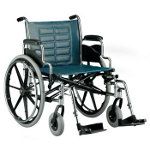 A wheelchair is probably one of the most recognized types of home medical equipment and dates back much further than other types of medical equipment. However, even though the history of the wheelchair, can be traced back many thousands of years, the modern wheelchair has roots that are much much younger.
A wheelchair is probably one of the most recognized types of home medical equipment and dates back much further than other types of medical equipment. However, even though the history of the wheelchair, can be traced back many thousands of years, the modern wheelchair has roots that are much much younger.
Manual Wheelchairs
Today, most manual wheelchairs feature a folding frame that is made out of lightweight hollow metal tubes. The seat has traditionally been made out of vinyl that is sewn around the wheelchair frame, although many newer wheelchairs incorporate improved padding and support. To allow the wheelchair user to self-propel, a manual wheelchair has large real wheels with metal hand-rims attached to the outside of the wheel.
The handrims allow the user to spin the wheels freely and easily, without making contact with the part of the tire that actually touches the ground. The front wheels are much smaller and are on pivots that allow the wheelchair to be turned simply by pushing it in a certain direction or by applying more pressure to one of the handrims.
These modern manual wheelchairs vary slightly in features, with some offering things like adjustable axles or different types of front rigging, which is the place at the front of the wheelchair where the user places their foot. However, the basic design is based on the Everest and Jenning’s Wheelchair(E&J Wheelchair) that was developed during the 1930′s. At this time, most wheelchairs where made out of a combination of wood and wicker, making them extraordinarily difficult to transport and also very hard to self-propel. Two inventors, named Everest and Jenning, set out to build a wheelchair that could be easily moved from place to place and also used without the help of a caretaker, creating a wheelchair frame whose influence can still be seen today in virtually all types of manual wheelchairs.
The manual wheelchair remains the most common type of wheelchair, with many people now opting to use a sports wheelchair, which is typically smaller and offers a number of performance improvements, but electric wheelchairs are also quite popular. Electric wheelchairs are much more expensive than manual wheelchairs, but since the device is powered by an electric motor, it requires little effort on the part of the user, aside from pushing the hand control in the desired direction.
Electric Wheelchairs and Power Chairs
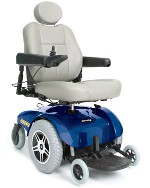 Electric wheelchairs come in a number of different shapes and sizes, as well as offering a number of different control methods, but the joystick control remains the most common. The joystick is mounted to one of the armrests of the wheelchair, allowing for either left hand or right hand use, with the wheelchair users simply pushing the joystick in the direction they wish to travel. For people with limited upper-body strength, a manual wheelchair is often too difficult to use, requiring a great deal of effort, which is the reason many people opt for an electric wheelchair, or power chair.
Electric wheelchairs come in a number of different shapes and sizes, as well as offering a number of different control methods, but the joystick control remains the most common. The joystick is mounted to one of the armrests of the wheelchair, allowing for either left hand or right hand use, with the wheelchair users simply pushing the joystick in the direction they wish to travel. For people with limited upper-body strength, a manual wheelchair is often too difficult to use, requiring a great deal of effort, which is the reason many people opt for an electric wheelchair, or power chair.
For those who are unable to use the joystick control, a number of alternate wheelchair controls are also available. One of the earliest alternate controls, which was first developed around the same time as the first electric wheelchair during the 1950′s, relies on head movements to steer the wheelchair. There are also remote controls available for caretakers, as well as a variety of much more advanced systems, including those that allow the power chair to be controlled by the breath of the user.
Wheelchairs continue to be one of the most common and well known types of home medical equipment, offering a way of improving accessibility. While power chairs are very convenient and easy to use, they tend to cost a lot more than manual wheelchairs, which can typically be found both new and used for at least a thousand dollars less than a power chair.
A Basic Guide to Manual and Electric Wheelchairs
Wednesday, May 12th, 2010
 A wheelchair might seem like a rather straightforward device, but there are many parts that go into a modern wheelchair, with some helping to improve the wheelchairs performance, as well as making it easier to use.
A wheelchair might seem like a rather straightforward device, but there are many parts that go into a modern wheelchair, with some helping to improve the wheelchairs performance, as well as making it easier to use.
Traditional Manual Wheelchairs
Today, most manual wheelchairs use a design that is based, at least in part, on the E&J wheelchair, which was developed right before WWII. Not everyone is familiar with the E&J Wheelchair, which is the name of its inventors, Everest and Jennings, but most people have seen them. This is the design that uses hollow metal tubes in the frame and a vinyl seat, which allows the wheelchair to be folded when not in use.
The innovation of this lightweight folding wheelchair made it much easier for those who used wheelchair to be get around when it was first developed, as most other wheelchairs were made of heavy wood and other bulky materials. This not only made it difficult to transport early wheelchairs, but it also made it hard for users to self-propel their wheelchair. The E&J Wheelchair solved these problems and its effect on the modern manual wheelchair can still be seen today.
Sports Wheelchairs
Of course, the sports wheelchair is becoming much more popular, which is a lightweight wheelchair, with performance in mind. There are many different types of wheelchair sports, with many sports having a special wheelchair design. For instance, the wheelchairs used in wheelchair basketball are surrounded by a protective cage and metal bumpers to prevent injuries.
However, there are many much more generic sports wheelchairs around, which are not necessarily designed for a specific sport, but instead include a number of performance features. This includes things like adjustable axles, smaller seats, low profile foot rigging, and many other performance tweaks that make it very maneuverable and fast. Many wheelchair users prefer the sports wheelchair design to that of a traditional folding wheelchair. As an example, most sports wheelchairs have a much lower back, which can make it much easier to turn and reach things behind you.
Electric Wheelchairs
While manual wheelchairs remain very popular, they require a good deal of energy to use, requiring that the person is fit and in good shape. This requires a lot of upper body strength and this is a factor that leads some to use Electric Wheelchairs, although a lot of people simply prefer a power chair to a manual wheelchair.
Power chairs utilize an electric motor and rechargeable battery, being very well suited for indoor use. Most preform well on packed ground as well, but some are more suited for outdoor use than others. Electric wheelchairs are more expensive than manual wheelchairs, but most travel over five miles on a single charge, which is no small task in a manual wheelchair.
There are several types of electric wheelchairs, but two of the most common are the rear-wheel drive wheelchair and the mid-wheel drive wheelchair. A rear wheel drive electric wheelchair provides a slightly stabler base and is a little bit better suited for outdoor use than a mid-wheel drive wheelchair. However, because the drive wheel in a mid-wheel drive wheelchair is located at the center of the device, they are often much more maneuverable.
Folding electric wheelchairs, as well as travel wheelchairs that can be taken apart are also available, which are not as high performance as regular power chairs, but are designed to be transported without a wheelchair lift.
For many, the wheelchair remains one of the most well known and common types of mobility vehicles, providing a service that is different from that of something like a mobility scooter. Wheelchairs have a rich history of innovation and are as common today, as they were 100 years ago.
A Look at Manual and Electric Wheelchairs
Tuesday, March 9th, 2010
The wheelchair is probably the most recognized type of mobility vehicle, with its invention being traced back over a thousand years. However, if you were to look at one of the wheelchairs used by people during the 1600′s and compare it to one of those used today, you would be hard pressed to find similarities, aside from both having wheels and their general function.
Manual Wheelchairs
 Today, wheelchairs are either manually powered or electric powered. Manual wheelchairs, or self-propelled wheelchairs, remain very popular and are often the least expensive option. Of course, there are exceptions to this rule, but generally a manual wheelchair costs about a third of what an electric wheelchair would.
Today, wheelchairs are either manually powered or electric powered. Manual wheelchairs, or self-propelled wheelchairs, remain very popular and are often the least expensive option. Of course, there are exceptions to this rule, but generally a manual wheelchair costs about a third of what an electric wheelchair would.
The general design of a manual wheelchair is based off of the 1920′s E&J Wheelchair Frame, which was a folding hollow-tubed wheelchair, designed to be easily transported. The basic design has not changed too much and the outline of the E&J wheelchair can still be seen in most modern wheelchair.
Most manual wheelchairs have a a large set of rear wheels, which can be turned by the person sitting in the wheelchair. A metal hand-rim extends from the rear wheel, providing a handhold for the user to grasp and spin the wheel, without having to touch the part that makes contact with the ground. The front wheels are usually much smaller and the front rigging of the wheelchair provides a footrest for the user, so their feet do not touch the ground.
The seat of a standard manual wheelchair is often made out of vinyl, which is looped around the metal tube framing of the wheelchair and sewn in place. However, more breathable fabrics are also available and are more common on sports wheelchairs. When not in use, the wheelchair can be folded up, making it much easier to transport.
While the majority of manual wheelchairs are self propelled, transport wheelchairs are also available, which are designed to be pushed from behind. Transport wheelchairs share a similar design, but the rear wheels are usually smaller and do not have handrims.
Electric Wheelchairs
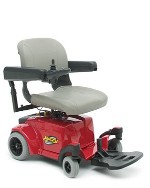 Electric wheelchairs are becoming much more common and offer the same basic functionality of a manual wheelchair, but the chair itself is powered by an electric motor, instead of the wheelchair user. The seat, which varies in size, but often resembles an office chair, is mounted atop a plastic base. The plastic base contains the electric motor and rechargeable battery that powers the wheelchair.
Electric wheelchairs are becoming much more common and offer the same basic functionality of a manual wheelchair, but the chair itself is powered by an electric motor, instead of the wheelchair user. The seat, which varies in size, but often resembles an office chair, is mounted atop a plastic base. The plastic base contains the electric motor and rechargeable battery that powers the wheelchair.
Like a manual wheelchair, electric wheelchairs provide a footrest, but the footrest is usually one piece of plastic, instead of the two individual footrests that are most common on a manual wheelchair. The standard control system for an electric wheelchair is a single joystick control that is mounted to the left or right armrest. The control system allows the wheelchair to be turned and moved by pushing on the joystick, as well as offering buttons to control the speed of the wheelchair. The range can vary depending on the model, as does the speed, but most quality electric wheelchairs can travel around 10 miles per charge and up to 4MPH.
Which is Better? Electric or Manual?
This is something that varies greatly by user and a lot of it comes down to personal preference. However, using a manual wheelchair can be quite strenuous, requiring a good deal of upper body strength, so this is often a factor. Cost also often plays a role, with many quality manual wheelchairs being available for under $500, while most electric wheelchairs cost over $2000.
Another factor to consider is where the wheelchair is going to be used and how often it will be used. A manual wheelchair may end up being easier to transport and better suited for indoor use, while for those who will be traveling across greater distances each day, an electric wheelchair might be a better choice.
Electric Wheelchair Buyers Guide and FAQ
Tuesday, February 2nd, 2010
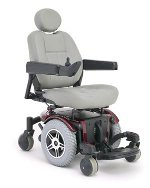 The wheelchair is one of the oldest known mobility aids, greatly improving the lives of those who have difficulty walking. There are many types of wheelchairs available, with sports wheelchairs becoming much more popular over the last ten years. However, for many the choice is whether to buy an electric wheelchair or a manual wheelchair, with both offering their own advantages.
The wheelchair is one of the oldest known mobility aids, greatly improving the lives of those who have difficulty walking. There are many types of wheelchairs available, with sports wheelchairs becoming much more popular over the last ten years. However, for many the choice is whether to buy an electric wheelchair or a manual wheelchair, with both offering their own advantages.
This guide provides the answers to some frequently asked questions about electric wheelchairs, which will help the consumer make an informed purchasing decision.
Electric wheelchairs, which are often called power chairs, are quite popular, but with so many choices and models available, it is important to understand how electric wheelchairs work and what their features are, before submitting to a high pressure sales pitch from your local medical supply store or online dealer.
Table of Contents
- What is an Electric Wheelchair?
- Electric Wheelchairs vs Manual Wheelchairs
- Where Can I Use An Electric Wheelchair?
- What is the Difference Between Mid-Wheel and Rear-Wheel Drive Power Chairs?
- How Are Power Chairs Controlled?
- Are There Any Alternate Control Systems Available for Power Chairs?
- How is the Chair Different Than a Manual Wheelchair?
- What Type of Range and Speed Should I Expect?
- How Do I Transport An Electric Wheelchair?
- What Are Travel Power Chairs?
- What Are Some Popular Power Chair Manufacturers?
What is an Electric Wheelchair?
An electric wheelchair is a motorized wheelchair that is powered using one or more rechargeable batteries. This allows the electric wheelchair, which is often referred to as a power chair, to be used easily away from the home, over both indoor and outdoor terrain.
The first electric wheelchairs, which were developed during the 1950′s, were simply manual wheelchairs that were outfitted with an electric motor, but today, they are custom made.
Electric Wheelchairs vs Manual Wheelchairs
Choosing between a manual wheelchair or an electric wheelchair is often a very personal decision, as they both offer advantages and disadvantages. In many cases, this comes down to personal preference, but there are several important things that should be considered when deciding whether to buy a power chair or a manual wheelchair.
The main advantage of an electric wheelchair is that it requires very little effort to use, while using a manual wheelchair is very strenuous. Where manual wheelchairs require that the user be pushed or self propel, with the latter requiring a great deal of upper-body strength, an electric wheelchair can be controlled with very little effort on the part of the user.
However, one disadvantage of electric wheelchairs is that they are much heavier and more difficult to transport than manual wheelchairs, which will be discussed later in the how do I transport an electric wheelchair section. Another consideration is that manual wheelchairs usually cost significantly less than power chairs.
Where Can I Use An Electric Wheelchair?
Like Mobility Scooters, electric wheelchairs are designed to be used both indoors and outdoors. However, they preform best over tightly packed surfaces. Due to their design, they are also not as well suited for outdoor travel as a mobility scooter is though, usually with a much shorter wheelbase and sometimes smaller wheels, making them work best over concrete or other hard surfaces.
However, unlike mobility scooters, an electric wheelchair can be driven directly up to a table or desk, in the same way that a manual wheelchair can.
What is the Difference Between Mid-Wheel and Rear-Wheel Drive Power Chairs?
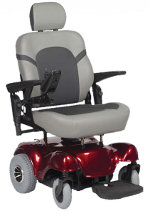 Rear-Wheel Drive Power Chairs typically have four wheels, which are spaced evenly apart from one another. The set of wheels in the back, the rear wheels, are what actually moves the power chair.
Rear-Wheel Drive Power Chairs typically have four wheels, which are spaced evenly apart from one another. The set of wheels in the back, the rear wheels, are what actually moves the power chair.
 Mid-Wheel Drive Power Chairs, on the other hand, usually have three sets of wheels. The set of wheels in the middle is positioned directly under the seat and the front and back set of wheels are positioned about the same as those on a Rear-Wheel Drive chair. However, it is the middle set of wheels that moves the wheelchair, with the front and back set of wheels providing support and stability.
Mid-Wheel Drive Power Chairs, on the other hand, usually have three sets of wheels. The set of wheels in the middle is positioned directly under the seat and the front and back set of wheels are positioned about the same as those on a Rear-Wheel Drive chair. However, it is the middle set of wheels that moves the wheelchair, with the front and back set of wheels providing support and stability.
The main advantage of a mid-wheel drive wheelchair is that it is more maneuverable than a rear wheel drive wheelchair. Like manual wheelchairs, electric wheelchairs are steered by moving one wheel, while holding the other still. A Mid-Wheel Power Chair allows for a much smaller turning radius, as the turning axis is directly below the wheelchairs seat.
In contrast, a rear-wheel drive wheelchair turns from the back, as this is where the drive wheels are, which means it will have a higher turning radius. However, because the weight of the rider is more evenly distributed between the front and back of the wheelchair, a rear wheel drive wheelchair is typically more stable and better able to support larger weights. To counteract this, some mid-wheel drive wheelchairs are considerably larger and include support wheels that are positioned further from the frame than normal.
How Are Power Chairs Controlled?
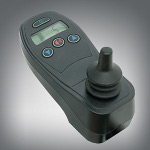 The basic control system that was first developed during the nineteen-fifties is still used today, with a joystick control being the standard control system for most electric wheelchairs. Of course, it is electronically based and made using much better technology, but the concept remains the same.
The basic control system that was first developed during the nineteen-fifties is still used today, with a joystick control being the standard control system for most electric wheelchairs. Of course, it is electronically based and made using much better technology, but the concept remains the same.
Typically, the joystick is mounted to the armrest on either side of the wheelchair, with most models also including simple throttle and horn controls as well.
Are There Any Alternate Control Systems Available for Power Chairs?
For those who are unable to use the traditional joystick control, a number of alternate wheelchair controls have been developed, with many of these having roots in the first wheelchair systems. Power chair control systems that allow the head to control the wheelchair are one of the more common, with several available that allow the wheelchair to be controlled by head movements.
Another popular option allows the users breath to control the movements of the wheelchair, with the user blowing through a small tube, similar to a straw, to move the wheelchair. There are also a number of experimental controls being developed, with one of the most promising allowing the user to control the wheelchair with their tongue, as it is common for movement of the tongue to remain, even in those who are otherwise paralyzed.
There are also a number of control systems developed with the caretaker in mind, which include remote control systems that allow the wheelchair to be controlled by someone walking behind it.
Also in development, there are several systems that allow the wheelchair to learn an environment, either by using GPS to map the environment or by manually adding map. This allows the wheelchair to navigate a room, building, or even campus, using proximity sensors to detect objects in the way. While still currently being developed, there are several live studies of these types of chairs, including one at a nursing home. Other potential controls, which could revolutionize wheelchair movements, include eye tracking software, which is able to detect where a user is looking.
How is the Chair Different Than a Manual Wheelchair?
The seat on most manual wheelchairs is made of vinyl, which is sewn around the frame of the wheelchair, although more breathable materials are also popular, especially on sports wheelchairs. However, the seat of an electric wheelchair more closely resembles a office chair. Some include a high back, with neck rest, while others have a much lower back, but they are typically made in a similar process, with a cushion built atop a hard flat board.
Depending on the model, some power chairs even have a reclining backrest and most allow the seat to be pivoted in both directions, making it easier to transport into and out of the chair.
If you buy a standard power chair, such as those made by Pride Mobility or Golden Technologies, there aren’t really too many options when it comes to the seat. However, special rehab seats are available, which include more supportive headrests, improved cushioning, and fully reclining seats. These power chairs also include individual leg rests that more closely resemble the leg rests used on a manual wheelchair, instead of the single platform that is usually provided for standard power chairs.
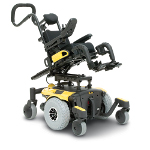 Pride Mobility’s Quantum Rehab division is one of the more well known offers of specialized power chairs, with bariatric and pediatric seats available that are mounted to one of their standard power chair bases. These seats also used a much more ergonomic cushioning that provides improved back support, as well as power tilt, which allows the seat to be reclined electronically.
Pride Mobility’s Quantum Rehab division is one of the more well known offers of specialized power chairs, with bariatric and pediatric seats available that are mounted to one of their standard power chair bases. These seats also used a much more ergonomic cushioning that provides improved back support, as well as power tilt, which allows the seat to be reclined electronically.
Back to Top
What Type of Range and Speed Should I Expect?
This varies depending on the model of scooter, as well as how it is used. However, most travel at speeds of between 3 and 4mph, with a range of around 15 miles.
One thing to keep in mind is that the range and speed is affected by the weight of the rider, as well as the terrain being traveled over. For example, if traveling uphill, the wheelchair’s battery will wear out faster and the chair itself will move slower than when traveling across flat ground.
Also, the battery will need to be replaced periodically, with the wheelchair loosing performance and range as the battery wears down.
How Do I Transport An Electric Wheelchair?
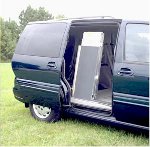 Electric wheelchairs are much heavier than manual wheelchairs and can not be folded up and placed in the trunk the same way you would with a self-propelled wheelchair. While most electric wheelchairs are designed to be taken apart, the individual pieces can be rather heavy and bulky. As a result, those who intend to use the wheelchair away from home, usually need to buy a wheelchair lift or a wheelchair ramp for their vehicle.
Electric wheelchairs are much heavier than manual wheelchairs and can not be folded up and placed in the trunk the same way you would with a self-propelled wheelchair. While most electric wheelchairs are designed to be taken apart, the individual pieces can be rather heavy and bulky. As a result, those who intend to use the wheelchair away from home, usually need to buy a wheelchair lift or a wheelchair ramp for their vehicle.
The least expensive option is the wheelchair ramp, with several foldable metal ramps available. These allow the wheelchair to be driven directly into a van, but do not work as well with other vehicles. Often, these ramps are not actually secured to the van itself, but there are also some van ramps available that are bolted to the floor of the van and can be folded down into place, making it much easier to use independently.
Wheelchair lifts are another option and offer much more flexibility, as they can be used on cars, trucks, SUVs, and Vans. Wheelchair lifts either act as a lifting platform, sort of like an elevator, or as a crane. They are also classified as either internal wheelchair lifts or external wheelchair lifts.
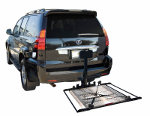 External Wheelchair Lifts are mounted to the hitch of a vehicle and typically store the wheelchair outside on the back end of the vehicle. However, there are several hitch mounted crane lifts that are used to move the wheelchair into inside of the vehicle.
External Wheelchair Lifts are mounted to the hitch of a vehicle and typically store the wheelchair outside on the back end of the vehicle. However, there are several hitch mounted crane lifts that are used to move the wheelchair into inside of the vehicle.
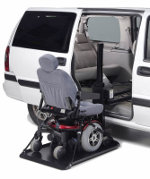 Internal Wheelchair Lifts, on the other hand, store the wheelchair on the inside of the vehicle. These work by either extending a platform from the vehicle onto the ground or by using the crane method. In vans, the platform lift works well when it is installed behind the drivers seat, with the mid row seating of the van removed. However, they can also be used on TRUCKS and SUVS. For passenger cars, a crane lift is usually the only option.
Internal Wheelchair Lifts, on the other hand, store the wheelchair on the inside of the vehicle. These work by either extending a platform from the vehicle onto the ground or by using the crane method. In vans, the platform lift works well when it is installed behind the drivers seat, with the mid row seating of the van removed. However, they can also be used on TRUCKS and SUVS. For passenger cars, a crane lift is usually the only option.
Wheelchair lifts are either powered by a rechargeable battery pack or by directly connecting to the vehicles battery. While wheelchair lifts that are connected to the vehicles battery are sometimes a little more complicated to set up, they end up being much lower maintenance, as you do not need to remember to charge the battery pack. Some wheelchair lifts also allow the wheelchairs charger to be plugged into it, so the wheelchair can be charged while on the road.
What Are Travel Power Chairs?
Travel Power Chairs are electric wheelchairs that are designed to be as lightweight as possible, which can make it easier to travel with them. They are usually designed to be taken apart easily, with the individual pieces being lighter and easier to manage. Also sometimes called portable power chairs, these wheelchairs can sometimes be transported without having to use a wheelchair lift.
However, this comes at the expense of features and range, as the wheelchair is stripped of as much weight as possible. This means a much smaller seat, with less padding, as well as a shorter range and weight capacity.
Folding Power Chairs are also available, which look similar to a manual wheelchair and can be folded in the same way. While these do take up less space than a standard power chair, they are still quite heavy, so are not often the best choice.
What Are Some Popular Power Chair Manufacturers?
Probably the most well known power chair manufactures are Pride Mobility and Golden Technologies, with both companies offering a number of popular and reliable electric wheelchairs. Pride’s Quantum Rehab line is also very popular, as they offer a number of wheelchairs with improved seating and controls, designed with rehab in mind.
While Pride Power Chairs and Golden Power Chairs are the most well known, there are many other manufacturers, with ShopRider Wheelchairs gaining popularity in the past few years by offering a lower price alternative.
When shopping for an electric wheelchair, however, it is important to not only focus on the price of the wheelchair and instead read reviews and consumer reports for each brand, while avoiding the many cheap no-name wheelchairs available. It is also important to make sure the company offers a comprehensive warranty.
Selecting the Right Type of Wheelchair
Monday, November 9th, 2009
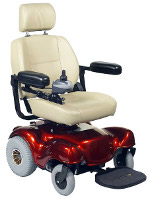 For the wheelchair user, choosing between an electric wheelchair and a manual one is often the first and hardest decision when it comes to selecting a mobility vehicle. Selecting the right wheelchair does not need to be difficult, however, and by determining your needs, the process can be made much simpler.
For the wheelchair user, choosing between an electric wheelchair and a manual one is often the first and hardest decision when it comes to selecting a mobility vehicle. Selecting the right wheelchair does not need to be difficult, however, and by determining your needs, the process can be made much simpler.
Considering the Cost of Electric and Manual Wheelchairs
One of the first factors for many trying to decide between a manual wheelchair and an electric wheelchair is price. Electric wheelchairs usually cost considerably more than manual wheelchairs.
Usually an electric wheelchair, or Power Chair, will cost between $1300 and $5000. The lower priced models usually come from lesser known wheelchair manufacturers, such as ShopRider, and the more expensive wheelchairs coming from manufacturers like Pride Mobility and Golden Technologies. While ShopRider Electric Wheelchairs are much less expensive, they do not have the same reputation as Golden Electric Wheelchairs and Pride Electric Wheelchairs.
Manual Wheelchairs usually cost much less, often around $500 and rarely over $1000. The exception to this is sports wheelchairs, which can sometimes cost just as much as electric wheelchairs. Sports wheelchairs are designed to be lightweight and durable, in addition being designed for specific types of wheelchair sports.
Considering the Wheelchair User’s Needs and Abilities
Another consideration when trying to decide whether to go with a power chair or a manual wheelchair is the abilities of the wheelchair user and how the wheelchair will be used. Depending on the users ability, using a manual wheelchair may not be an option, as they require a great deal of upper body strength. Even people who are in excellent shape find that a manual wheelchair can be very strenuous.
In regards to how the wheelchair will be used, it is important to spend some time thinking about what places you are likely to take the wheelchair. If it is just going to be used in the home most of the time, having an electric wheelchair may very well be unnecessary.
However, those who plan on using their wheelchair to travel across more than a mile or two each day, such as a college student, may find that an electric wheelchair is a much better choice. This is because most electric wheelchairs, even the lower end models, can travel more than 5 miles on a charge, with most having a range between 10 and 20 miles per charge.
Transporting the Wheelchair
Considerations on transporting the wheelchair should be thought about before actually purchasing a wheelchair, because it is a very important factor. In some regards it ties into the above topic of where the wheelchair will be used.
Typically, transporting a manual wheelchair is very easy, as they are designed to be folded up and are lightweight enough that they can easily be lifted into the back seat of a car or the trunk area. This makes using a manual wheelchair away from home very easy.
Electric wheelchairs are not as easy to transport and usually require that some sort of wheelchair lift be installed on the vehicle. This adds to the total cost of ownership of an electric wheelchair, but vehicle wheelchair lifts are very convenient and easy to use.
Selecting the right type of wheelchair need not be difficult, but it is also not a decision that should be taken lightly. It is essential to take into account the user and their needs, as well as other factors, such as cost and ease of transportation.
Self-Propelled Wheelchairs and Power Chairs
Monday, October 12th, 2009
Over the history of mankind, there have always been inventions that are designed to help those who can not walk. In the grand scheme of things these devices are considered to be wheelchairs, but they are not usually what most people think of as a wheelchair. Instead, the hollow tubbed metal frame with its vinyl seats that most people first think of when considering a wheelchair is a new invention that has been around for less than 100 years.
Today, there are countless models and brands of wheelchairs, enough that it can almost be overwhelming when trying to shop for a wheelchair, but they all share a very similar design. This is not only true of most manual wheelchairs, but also electric wheelchairs.
Basic Manual Wheelchair Design
Most self-propelled manual wheelchairs have two rear wheels that are larger in size. The rear wheels have another smaller rim attached to the outside of the wheel, which allows the user to spin the wheel, without having to actually touch that parts that makes contact with the ground.
Most manual wheelchairs also have a set of push handles attached to the frame of the wheelchair, which allow it to be pushed easily. Transfer wheelchairs, which are not designed to be self-propelled, do not usually have handrims on the rear wheel and instead the rear wheels are only slightly larger than the front wheels.
The Folding Wheelchair Frame
The typical manual wheelchair is also designed to be folded when not in use, which allows it to be placed in the rear of a car without the need of a vehicle wheelchair use. This also makes them well suited for traveling. The frame of the wheelchair is made out of hollow tubes of metal, with steel being the most common type, which is very sturdy and lightweight. Other metals are also sometimes used, but they tend to be more expensive, with the main advantage of these alternate metals being their lightweight. Many sports wheelchairs will make use of a non-steel metal.
Differences Between Manual and Electric Wheelchairs
While electric wheelchairs no longer use a design that is very similar to a manual wheelchair, they do all standard design. Most consist of a small plastic base, which houses the electric motor, rechargeable batteries, axles, and other electrical components. The chair is attached to the base of the wheelchair and armrest controls are usually attached, using a simple joystick control scheme. This allows the wheelchair to be controlled by simply pushing the joystick in the desired direction. The joystick can be configured for either right hand or left hand use, by simply changing which side of the armrest it is attached to.
Of course, there are a number of people who can not use the standard wheelchair control, so there are a number of alternative wheelchair controls available. This includes wheelchairs that are controlled by head movements, the users breath, and even by remote control.
In the case of electric wheelchairs, they can usually travel between 4 and 8 miles per charge, although this is something that varies depending on the weight of the user and the type of terrain the wheelchair is driven over. For instance, driving an electric wheelchair up a hill repeatedly will wear it down faster than if it were driven across flat ground.
Electric Wheelchairs and How They Are Put Together
Monday, October 5th, 2009
Wheelchairs are very powerful tools that have a history dating back thousands of years. However, most of the technology behind the modern wheelchair, with of course the exception of the wheel itself, is much newer. Instead, the modern manual wheelchair based off of the E&J design, which is characterized by a lightweight hollow tubed frame, which can be folded when not in use.
Today, manual wheelchairs remain incredibly popular, but the electric wheelchair is also a very common choice for the wheelchair user. Not too surprisingly, the modern electric wheelchair also has its roots in the E&J Wheelchair design. This is because the first electric wheelchairs were simply E&J wheelchairs that had been outfitted with an electric motor. Early manufacturer would sell electric conversion kits designed for use with the E&J design, but today the electric wheelchair has a significantly different design that to that of a manual wheelchair.
Most modern electric wheelchairs, which are often called power chairs, feature a relatively small base, which is covered in molded plastic. The base contains the electric motor, wiring, wheel base, and rechargeable batteries of the wheelchair. Some are quite small, while others have a much large wheel base, resulting in a much larger wheelchair. Attached to the top of the wheelchair base is a chair, which can usually be swiveled to make entering or exiting the wheelchair much easier.
The reason the base of an electric wheelchair is so small, especially when compared to that of a mobility scooter, is that by design a wheelchair must be able to be driven directly up to a table or desk, without requiring its user to transfer to another chair or a bench. For heavy duty electric wheelchairs, the base is usually larger, but it is still designed so that the power chair can be driven directly up to a desk.
Rear-Wheel Drive Wheelchairs
The number of wheels on a power chair is one way that they are classified. Rear wheel drive wheelchairs usually have a set of wheels in the front and a set of wheels in the back. The rear wheels are responsible for moving the wheelchair and are slightly larger than the front wheels, which are typically there for support only.
One of the advantages of a rear-wheel drive power chair is that they are very stable. The weight of the user is spread out more evenly around the base of the chair, resulting in a very stable wheelchair.
Mid-Wheel Drive Wheelchairs
The Mid-Wheel Drive Wheelchair actually has three sets of wheels. The front set and rear set are much smaller and are designed to provide stability and support. It is the mid wheels that are responsible for moving and turning the wheelchair, which offers the advantage of greatly improved maneuverability. This is an important feature, as many wheelchair users rely on their power chair for indoor use.
However, it is at the expense of the extra stability offered by a rear-wheel drive power chair. This is because most of the weight is placed on the mid-wheel, which significantly changes the wheelchairs center of balance. This is not to say that mid-wheel drive wheelchairs are unstable, simply that they are less stable than rear-wheel drive wheelchairs. As a result, for outdoor use or high weight capacity, a rear-wheel drive power chair will usually provide better service.
Choosing Between a Manual Wheelchair and a Power Chair
Tuesday, September 15th, 2009
In today’s world, the choice of manual or electric often gets looked upon as an easy choice, with power almost always getting looked upon as the easier and more efficient solution. This can be seen in most peoples choice of power tools, power windows, and power steering. However, in the world of manual and electric wheelchairs, the choice is not so straightforward or easy, as both have advantages and disadvantages.
A Look Back at the History of the Wheelchair
Wheelchairs have been used for thousands of years, with images being found that indicate ancient Asians were among some of the first to make use of a wheelchair for those who had difficulty walking. During the middle ages, wheelchairs would be relatively common, but because they had to be custom made, they were almost only available to those who had the resources to build them, such as figures of nobility.
It would not be until much later during the early nineteenth century that wheelchairs would take on a more standard design, using a simple foldable lightweight steel tube frame. Today, this same design remains incredibly popular among manual wheelchairs and electric wheelchairs are also very common, with an electric motor concealed in a base made of molded plastic and a seat attached to the base of the wheelchair.
Choosing the Right Wheelchair: The User
One of the first , and arguably most important, steps in deciding whether to use a manual wheelchair or an electric wheelchair revolves around the physical abilities of the wheelchair user. It takes a great deal of physical effort to use a manual wheelchair and this can put a great deal of stress on the upper-body. As a result, using a manual wheelchair can be very strenuous, too much so for many
There is of course also something to be said for personal preference, as many people enjoy using a manual wheelchair precisely because it requires more physical effort. There are a number of sports, such as wheelchair basketball, wheelchair tennis, and wheelchair racing, which make extensive use of manual wheelchairs as well and many wheelchair users prefer the feeling of independence and flexibility that is offered by using a manual wheelchair. .
Choosing the Right Wheelchair: The Location
While the physical condition of the wheelchair user is one of the most important considerations, the location where the wheelchair will be used is also important. For example, if the wheelchair is primarily going to be used around home, then it will require much less upper-body strength to use than if it were to be used around a college campus. As a result, for home use, many people prefer the simple and less complicated design of a manual wheelchair.
However, those that will be using the wheelchair across larger distances, such as around town or driving around the neighborhood, might be better served with an electric wheelchair.
Choosing the Right Wheelchair: The Cost
One of the other major considerations when choosing between an electric wheelchair or a manual wheelchair is the cost of the device. While it is possible to spend a great deal on a manual wheelchair, they still typically cost a great deal less than an electric wheelchair. For those who are unable to get a Medicare wheelchair, Medicaid Wheelchair, or other insurance discount, an electric wheelchair might simply not be affordable.
A Quick Look at the Power Chair
Monday, August 24th, 2009
Electric wheelchairs, which are often called power chairs, have been around for over fifty years and are very important, because many people are not able to use a manual wheelchair, which requires a great deal of upper body strength. However, power chairs have changed a great deal since when they were first invented.
The power chairs of fifty years ago were simply manual wheelchairs that had been fitted with an electrical motor. The E & J manual wheelchair was very popular at the time and consisted of a foldable frame made up of hollow steel tubes. A number of companies began to develop power chair converter kits, which could be easily added to the E & J frame, turning it into an electric wheelchair. Today, while the influence of the E & J design can still be seen in most manual wheelchairs, power chairs are actually much different.
Modern power chairs consist of a molded plastic base, which consists of the wheels, electric motor, rechargeable battery, and other electrical components. A chair is attached to the base, which in someways looks similar to a high-end office chair, except many also include an adjustable headrest.
The chair, which is referred to as the Captain’s Chair, usually has an adjustable height and armrests that can be raised or lowered to make it easier to transfer into and out of the electric wheelchair. Typically, the chair can be quickly removed from the base of the power chair, to make it easier to transport.
While there have been many changes to the power chair over the years, one thing that has remained the same is the way the wheelchair is controlled. Of course there have been many technological advances, but the joystick has been the traditional wheelchair control since they were first developed. The joystick of the wheelchair allows the wheelchair to be moved in any direction by simply pushing the joystick in the desired direction. An electric throttle, which controls the speed of the power chair, is also usually attached to the captain chair’s armrest.
The joystick control usually only requires a single finger to operate, but for some using the standard control is not possible, so a number of alternate controls exist. Alternate controls can be as simple as a allowing for head movements to move the electric wheelchair, but there are many much more advanced control systems available.
Today, portable power chairs are becoming more popular and manufacturers have begun to manufacture travel power chairs, which are designed to be quickly and easily disassembled into several easy to manage pieces. Individually the pieces are typically rather light, which means the wheelchair can be transported without requiring a wheelchair lift or other type of wheelchair carrier. Of course, to help reduce weight, they usually lack features and do not have as comfortable of a chair. However, portable power chairs can be very useful for those who will be traveling on a plane or other form of public transportation.
Power chairs are today very common, but the manual wheelchair is still the most used type of wheelchair.
The History of the Modern Manual Wheelchair
Friday, August 21st, 2009
Manual wheelchairs are one of the oldest types of wheelchairs known to man and records of their use can be traced back thousands of years. However, up until the end of the nineteenth century, there was very little standardization when it came to manual wheelchairs and they were often only available to people who had the resources to hire a professional builder.
Wicker and Wood: Early Wheelchair Designs
Towards the end of the nineteenth century, however, the wicker basket wheelchair began to become very popular. These wheelchairs provided a wicker seat for the person using the wheelchair, which had a very long and high back. These wicker wheelchairs had three wheels and were not only incredibly bulky, but also very heavy.
As a result of how these wheelchairs were designed, it was very difficult to transport a wicker wheelchair and it was also very difficult for the person using the wheelchair to move it on their own. Instead, they were forced to rely on nurses and family members to push the wheelchair if they wanted to move around.
In addition to the wicker wheelchairs, there were also several popular wooden wheelchairs, which were also incredibly heavy and difficult to transport, but were easier to self propel than the wicker wheelchair.
The Development of a Lighter Easier to Use Manual Wheelchair
Despite all their flaws, the wicker wheelchair would remain the standard in wheelchair design for over two decades until the 1930′s, when the first foldable tube framed manual wheelchair was developed. This new wheelchair was created by two inventors named Everest and Jennings and would come to be called the E & J Wheelchair.
Harry Jennings set out to build a newer lightweight wheelchair when he saw the difficulties his friend Herbert Everest was having using the standard wicker wheelchair. Together, they came up with a very innovative wheelchair design, which used hollow metal tubes and a foldable frame. By using metal tubes, they were able to create an incredibly strong wheelchair frame, which was also relatively lightweight.
The E & J Wheelchair frame could also be folded up and placed in a carriage or other vehicle, making easily traveling with a wheelchair possible for the first time. As the E & J Wheelchair was being developed, the build up to the Second World War was beginning and the E & J Wheelchair would soon have a number of users.
The First Electric Wheelchairs
The E & J wheelchair was also used as the base of the first electric wheelchair, when inventors in the 1950′s developed an electric motor that could be attached to the frame of an E & J wheelchair. This allowed the E & J wheelchair to be easily turned into an electric power chair and several companies began selling conversion kits for the E & J Frame.
The Wheelchairs of Today
The E & J manual wheelchair quickly became the standard and was used worldwide. Today, E & J wheelchairs are still available and their influence can be seen in virtually all modern manual wheelchairs.